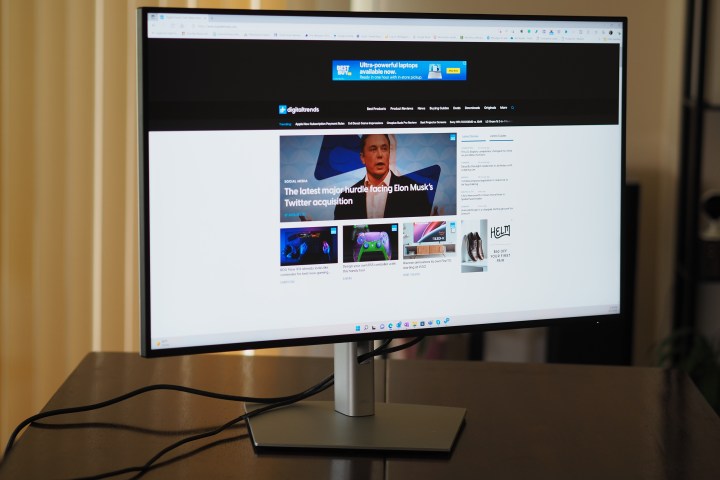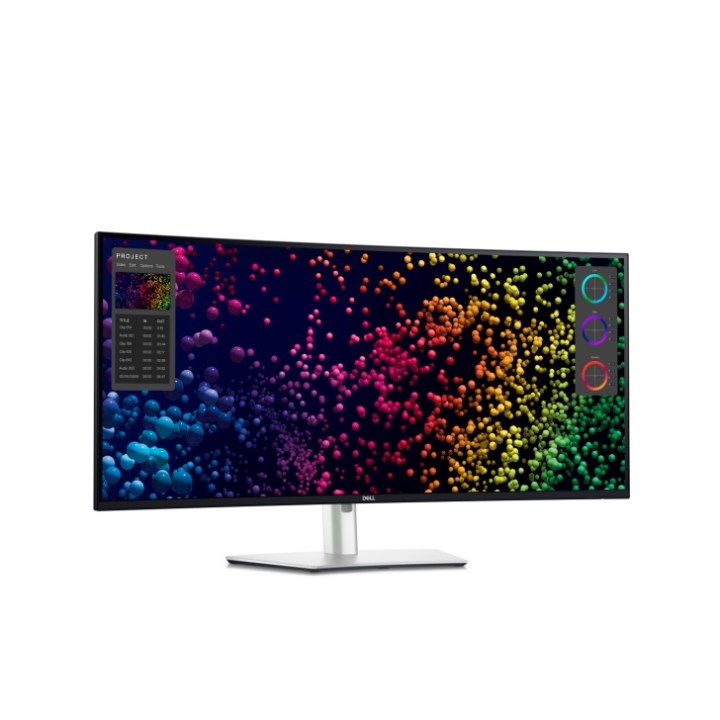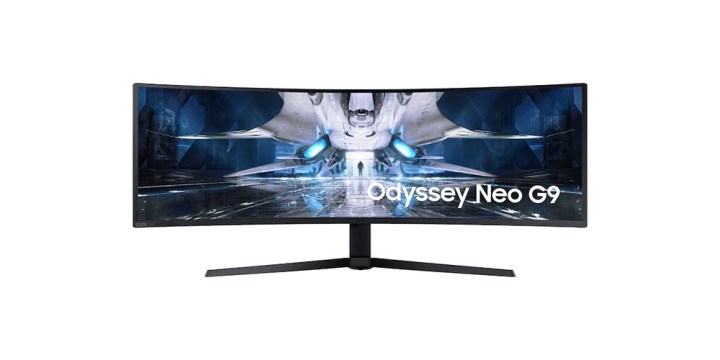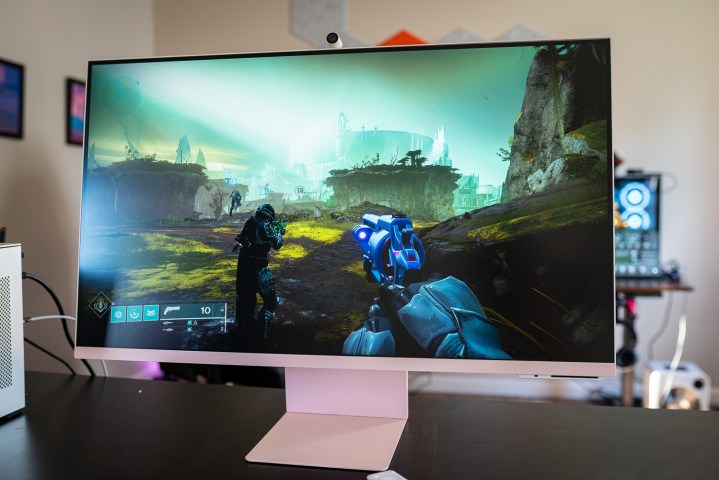For those seeking a superior computer setup, a cutting-edge monitor is non-negotiable. As we move into 2024, the monitor market offers a wide range of options tailored to various needs, from immersive gaming displays to high-resolution panels for creative professionals. Whether you're looking for top-tier gaming performance with fast refresh rates, crisp visuals for productivity, or a versatile all-rounder, this year’s monitors bring cutting-edge features like OLED panels, high refresh rates, and enhanced connectivity. In this guide, we'll explore the best monitors you can buy in 2024, ensuring you find the perfect fit for your setup.
Investing in a good PC monitor can enhance your computing experience in several ways:
Visual quality: A high-quality monitor offers superior visual clarity, color accuracy, and sharpness compared to budget or older monitors. This is particularly important for tasks like graphic design, photo editing, and gaming, where color accuracy and detail are crucial.
Resolution and refresh rate: A good monitor often comes with higher resolutions (such as 1440p or 4K) and faster refresh rates (such as 120Hz or 144Hz). This results in a smoother, more immersive gaming experience, reduced motion blur, and improved overall screen performance.
Panel type: Premium monitors often use advanced panel technologies like IPS (In-Plane Switching) or OLED (Organic Light-Emitting Diode) for better color reproduction, wider viewing angles, and deeper blacks. These panels provide a more enjoyable viewing experience for various tasks, including watching videos or working on creative projects.
Productivity and multitasking: A larger, high-resolution monitor enhances productivity by providing more screen real estate for multitasking, running multiple applications side by side, and improving workflow efficiency.
Adaptive sync and gaming features: Many high-end monitors come with features like Nvidia G-Sync or AMD FreeSync, which synchronize the monitor's refresh rate with the graphics card's frame rate. This eliminates screen tearing and stuttering, resulting in smoother gameplay for gamers.
Adjustability and ergonomics: Good monitors offer ergonomic features such as height adjustment, tilt, swivel, and pivot, allowing you to customize the viewing angle for comfort and reduced eye strain. This is beneficial for long hours of work or gaming sessions.
Connectivity options: Premium monitors typically offer a wide range of connectivity options, including HDMI, DisplayPort, USB-C, and more. This versatility allows you to connect multiple devices simultaneously and switch between them seamlessly.
Long-term investment: A high-quality monitor is a long-term investment that can last for several years without needing an upgrade. It provides consistent performance and reliability, saving you money in the long run compared to frequently replacing cheaper monitors.
Read on to see which monitors we recommend for gaming, home use, and more.











The best monitor you can buy
Dell UltraSharp 32 4K
- Large, sharp 4K IPS panel
- Excellent image quality
- Truly useful USB-C hub and KVM switch
- Outstanding build quality and design
- Standout warranty and support
- Expensive
- HDR support is so-so
Why you should buy this: It's a gorgeous screen with thin bezels and deep blacks.
Who it’s for: Anyone who wants a premium monitor that will last years.
Why we picked the Dell UltraSharp 32 4K:
Dell's UItraSharp 32 4K isn't the cheapest monitor out there, but it's the best. It offers a balance of beautiful image quality and features that few monitors can nail, and does so at a reasonable price.
We specifically reviewed the 32-inch model, which is more expensive than the 27-inch version (the U2723QE). Most people are fine with the 27-inch version, though the 4K resolution looks its best on a 32-inch panel. Regardless of the size, both monitors use an IPS Black panel, which provides wide color coverage and excellent color accuracy. It's also significantly brighter than a standard IPS panel, offering up about twice the contrast you'd normally find.
Outside of image quality, Dell's UltraSharp 4K displays feature an integrated USB-C hub that's surprisingly useful. It sports up to 90 watts of power delivery, and it gives you a one-cable solution for connecting a laptop to the display. With the single USB-C cord, you can daisy-chain a second monitor, connect to the Ethernet port, and access both DisplayPort and HDMI connections. The monitor even comes with a KVM switch, allowing you to quickly swap your peripherals between devices.


The best gaming monitor
MSI MPG 321URX QD-OLED
- Much cheaper than the competition
- Some of the best color we've seen
- Extensive list of OLED burn-in prevention features
- 1,000 nits of brightness
- 3-year warranty that covers burn-in
- A rather bland design
- Limited to USB 2.0 with integrated hub
Why you should buy this: An exceptionally good OLED gaming monitor with a competitive price tag.
Who it’s for: Gamers who want the most immersive gaming experience.
Why we picked the MSI MPG 321URX QD-OLED:
MSI's MPG 321URX QD-OLED gaming monitor stands out for its exceptional image quality at a lower cost compared to competitors, with an MSRP of $950. The monitor boasts impressive features such as OLED burn-in prevention, 1,000 nits of brightness, and a three-year warranty covering burn-in issues. Despite its pros, including vibrant colors and a reasonable price, it falls short in design aesthetics and is limited to USB 2.0 connectivity with an integrated hub.
The monitor's design is modest, with a plastic shell and a glossy finish that complements its OLED panel. It offers extensive adjustment options, including height, tilt, swivel, and pivot, making it versatile for different setups. While lacking some advanced features found in competitors, such as Black Frame Insertion (BFI), the MPG 321URX excels in image quality, gaming performance, and burn-in prevention features, making it a compelling choice for those seeking a high-quality OLED gaming monitor without breaking the bank.


Best OLED monitor
Asus ROG Strix XG27AQDMG
- The brightest OLED monitor we've reviewed
- Much cheaper than the competition
- Three-year warranty
- Glossy panel
- Beautiful HDR and color accuracy
- Slightly cheaper stand
- No KVM switch or USB-C
Why you should buy this: An excellent OLED monitor that offers great colors and brightness.
Who it’s for: Users who primarily use their PC to consume media.
Why we picked the Asus ROG Strix XG27AQDMG:
The Asus ROG Strix XG27AQDMG offers impressive features and improvements over its predecessor, the PG27AQDM, including a brighter OLED panel and a glossy finish. Currently priced at $700, it stands out for its affordability compared to other OLED monitors. Key enhancements include a 20% increase in brightness, hitting peak HDR brightness of 1,176 nits, and excellent color accuracy. While it has a simpler stand and lacks features like a KVM switch or USB-C ports, the monitor excels in providing a high-quality gaming experience with features like Extreme Low Motion Blur (ELMB) for improved motion clarity.
Despite its lower price point, the XG27AQDMG maintains premium features such as Adaptive Sync, AMD FreeSync Premium, Nvidia G-Sync, and a 240Hz refresh rate. The monitor's design includes a thinner panel, passive cooling, and an external power brick for a sleek look. It also offers versatile stand adjustments and a range of color settings. Asus includes a three-year warranty covering burn-in, along with various burn-in prevention features. Overall, the XG27AQDMG delivers on performance and brightness, making it a strong contender in the OLED gaming monitor market.


The best 5K monitor
Dell UltraSharp U4025QW
- 120Hz refresh rate
- Network KVM switch
- Great image quality
- Built-in Thunderbolt
- Expensive
- Ultrawide isn't for everyone
Why you should buy this: A high-quality 5K monitor packed with modern I/O.
Who it’s for: Those looking for a premium, high resolution display from enhanced productivity.
Why we picked the Dell UltraSharp U4025QW:
Dell unveiled its updated 40-inch curved 5K monitor earlier this year, now available for purchase as the Dell UltraSharp U4025QW 40-inch Curved Thunderbolt hub monitor. Packed with a plethora of I/O options, this monitor supports up to 140 watts of power delivery via Thunderbolt 4, alongside HDMI 2.1, DisplayPort 1.4, an RJ45 Ethernet jack, and various USB ports. It even features pop-down, forward-facing USB ports similar to Dell's 6K UltraSharp monitor.
The monitor's 5K resolution (5120 x 2160) panel has been significantly upgraded, now supporting a smooth 120Hz refresh rate and utilizing IPS Black technology for improved contrast. While it may not achieve the deep blacks of OLED displays, Dell believes it strikes a good balance in contrast. Additional features include an ambient light sensor for automatic brightness and color temperature adjustments, reduced blue light emissions for enhanced eye comfort, and a built-in Network KVM switch for seamless multitasking across multiple network-connected PCs and monitors using a single keyboard and mouse.


Best ultrawide monitor
Samsung Odyssey Neo G9
- Large 49-inch screen
- Excellent contrast
- HDMI 2.1 support
- Fast response time
- 240Hz refresh rate
- Expensive
- Can be large for some desks
Why you should buy this: A premium ultrawide monitor suitable for all
Who it’s for: Anyone who is looking for plenty of screen real estate.
Why we picked the Samsung Odyssey Neo G9:
The Samsung Odyssey Neo G9 is our pick for the best ultrawide monitor. Featuring a massive 49 inch screen, the monitor features mini-LED backlighting which translates to excellent brightness along with impressive local dimming which helps it display deep blacks. The Odyssey Neo G9 is suitable for most use cases. The sheer size and high-resolution of the screen ensures that you can multitask with ease. It is also great for content creation and media consumption as the panel is capable of reproducing vivid colors with high contrast and deep blacks.
It is primarily a gaming monitor, which means you get all the latest tech including a 240Hz refresh rate and native support for FreeSync variable refresh rate (VRR) technology and G-SYNC compatibility to effectively minimize screen tearing. You also get two HDMI 2.1 inputs to fully capitalize on the latest gaming consoles or graphics cards.


Best smart monitor
Samsung M8 Smart Monitor
- Works as a smart TV or a monitor
- Supports Samsung Gaming Hub
- Attractive design
- 65W USB-C power delivery
- Good SDR image quality
- Limited HDR performance
- No VESA mount and limited stand adjustment
- Webcam features aren't available on a PC
Why you should buy this: A feature-packed monitor that can also be used as a TV.
Who it’s for: Users lacking the room, budget, or inclination for two sizable and costly screens.
Why we picked the Samsung M8 Smart Monitor:
The Samsung M8 Smart Monitor, attempts to bridge the gap between TVs and monitors, offering a versatile solution. Boasting an attractive design with vibrant color options, the M8 resembles the M1 iMac in terms of aesthetics. Its height-adjustable stand and thin bezels contribute to a sleek look. The monitor supports Samsung's TV operating system, Tizen, providing access to apps like Netflix, YouTube, and Apple TV+. While it offers features like Samsung Gaming Hub and Samsung Workspace, the transition between monitor and TV modes is not seamless, making users choose one mode over the other.
With its 32-inch 4K VA panel, the M8 delivers good SDR image quality, but its HDR performance is limited. The monitor lacks VESA mounting options and offers minimal stand adjustments, which may limit flexibility. The bundled magnetic webcam offers good quality and offers features like face tracking and auto-framing. Gaming on the M8 is constrained by its 60Hz refresh rate and a limited port selection, with options like mini HDMI and USB-C. Overall, the Samsung M8 is suitable for those who need its unique combination of TV and monitor functionalities, but alternative options may better cater to specific preferences or use cases.
The Samsung M8 Smart Monitor is currently on sale and at its lowest price of $500, which is a pretty solid deal.


The best monitor for Mac
Apple Studio Display
- Beautiful 5K panel
- Built-in webcam and microphone
- Siri support
- Expensive
- Limited port selection
Why you should buy this: It's a stunning 5K monitor that pairs perfectly with Macs.
Who it’s for: Apple users who want a premium display.
Why we picked the Apple Studio Display:
Apple's Studio Display was a controversial monitor when it first launched, but there's no denying that it's a perfect pairing with any Mac. The 5K Retina display is stunning, offering up 218 pixels per inch on the 27-inch monitor. It also comes with wide color coverage and boasts up to 600 nits of peak brightness.
The display itself is stunning, but the integration with Macs is why the Studio Display topped our list of the best monitors for the Mac mini. The built-in camera and microphone array are tuned for FaceTime calls, and the display even supports Siri commands. The camera also supports Apple's Center Stage to automatically frame you.
For connectivity, you get a Thunderbolt 3 input that provides up to 96 watts of power delivery, along with three downstream USB-C ports. The monitor is built for Macs, but due to the Thunderbolt 3 connection, you can also connect an iPad Pro or iPad Air.


Best monitor for creative work
Asus ProArt PA32UCG-K
- Exceptional color accuracy
- 1600 nits HDR brightness
- 4K resolution with 120Hz refresh rate
- Included hood and light meter
- Very expensive
- Heavy to move
Why you should buy this: A top -class monitor with excellent color accuracy, brightness, and clarity.
Who it’s for: Professionals who need a premium monitor for content creation.
Why we picked the Asus ProArt PA32UCG-K:
The Asus ProArt PA32UCG is a top-tier professional monitor that comes with a hefty $5,000 price tag, but it's currently selling for $2,800. It offers exceptional performance and comprehensive features that justify the investment for professionals. With a 4K resolution (3840 x 2160) and 120Hz refresh rate, this 32-inch monitor is rated to support 100% of sRGB, 99.5% of AdobeRGB, and 98% of DCI-P3 color gamut.
Apart from offering great image quality, the monitor delivers excellent accuracy across various color modes and supports every gamut, grayscale, and gamma standard. Thanks to the inclusion of Dolby Vision support, it further enhances its versatility for professional use. The monitor also comes with essential accessories such as a light hood and color meter, enhancing its appeal for users who demand precise color representation.
With full-array mini-LED backlighting, there are 1152 dimming zones, and the monitor can achieve a peak HDR output of 1600 nits. Its extensive OSD controls allow for fine-tuning of gamma, color temperature, and gamut, ensuring optimal performance tailored to individual preferences. The PA32UCG's exceptional capabilities make it worthwhile for professionals seeking uncompromising accuracy and even gamers craving immersive visual experiences.


Value-for-the-money 4K monitor
HP Omen 27k
- Reasonably priced
- Super sharp
- USB-C input
- Great color accuracy
- KVM switch
- Poor HDR performance
- Artifacts at high overdrive levels
- No cable management
Why you should buy this: It's a 4K monitor with premium features under $400.
Who it’s for: Those who want a high-resolution display without spending too much.
Why we picked the HP Omen 27k:
HP’s Omen 27k breaks the mold by offering a 4K display at an affordable price, typically around $400 and even less on sale. This 27-inch monitor features a high 144Hz refresh rate, USB-C connectivity, and a KVM switch, making it a standout in the budget category. Although it doesn’t excel in brightness or HDR performance, the Omen 27k’s combination of 4K resolution and premium features make it an attractive option for gamers looking for value without compromising on essential features.
The design of the Omen 27k is straightforward, with a black plastic shell, subtle bias lighting, and a sturdy metal base. It includes standard ergonomic adjustments but lacks cable management solutions, which could be a downside for those who prefer a tidy setup. Despite this, the Omen 27k’s impressive color accuracy, decent brightness, and additional features like built-in speakers and USB-C port make it a solid choice for gamers seeking a high-quality, budget-friendly monitor.


Best 1080p monitor
LG Ultragear 27GP750-B
- Affordable price
- Fast refresh rate and response time
- Good viewing angles
- Average HDR performance
Why you should buy this: A value 1080p gaming monitor that is also good for everyday work
Who it’s for: Users on a tight budget who need a reliable monitor.
Why we picked the LG Ultragear 27GP750-B:
We could recommend a boring office monitor if you need the bare minimum. But the LG Ultragear 27GP750-B gaming monitor is available at an equally competitive price. The monitor comes with a Full HD IPS panel that delivers vivid colors and wide viewing angles, enhancing the overall viewing experience. With a 240Hz refresh rate, one can expect smooth and responsive performance, which is great for everyday computing as well as gaming.
Its ergonomic design allows for height, tilt, and pivot adjustments, ensuring comfort while the slim bezel and sleek black design give it a modern look. Other notable features include a 1ms response time, Nvidia G-Sync compatibility, and support for HDR10. Currently priced at $220, it is a no-brainer if you are strictly looking for a 1080p monitor on a budget.

Frequently Asked Questions
No one monitor brand makes all the best monitors in the world — that’s why this list is populated by a number of different manufacturers. That said, there are some that you can rely on more than most to produce great screens. Dell is a longstanding favorite of ours with years of fantastic displays under its belt. It also tends to cater well to the professional crowd just as much as gamers, so you know there will be something you like in its lineup.
Other noteworthy brands worth considering include Acer, which tends to produce some of the world’s best gaming screens; Samsung, which offers some of the best ultrawide screens and large-size monitors we’ve ever seen; and LG, which has a good all-around catalog of displays.
This very much depends on the resolution you’re targeting and how much desk space you have. While bigger does tend to look better, giving you more screen space for work and larger images for games and movies, they can stretch entry-level resolutions like 1080p to the limits of their clarity. Big screens also require more room on your desk, so we’d caution buying a massive ultrawide like the Samsung Odyssey series if you’re working or playing on a small desk.
As a quick rule of thumb, 1080p looks great up to about 24 inches, while 1440p looks good up to and beyond 30 inches. We wouldn’t recommend a 4K screen any smaller than 27 inches as you aren’t going to see the real benefit of those extra pixels in what is a relatively small space by that resolution.
They can be. 4K offers the pinnacle of gaming detail and, in atmospheric games, can give you a whole new level of immersion, especially on larger displays that can fully display that mass of those pixels in all their glory. These high-res displays really excel in games where frame rates are not as important as visual clarity. That said, we feel that high refresh rate monitors can deliver a better experience (especially in fast-paced games like shooters), and unless you have the deep pockets to splash out on a powerful graphics card or two as well, you aren’t going to get those frame rates at 4K. A 27-inch, 1440p display is still the sweet spot.
Also, keep in mind monitor performance is now often linked to framerate management technologies like FreeSync and G-Sync, so watch for these technologies and compatible graphics cards when making gaming monitor decisions. FreeSync is for AMD graphics cards, while G-Sync only works with Nvidia’s GPUs.
The short answer is they’re both the same. The longer answer is that this is a failure of company marketing in properly conveying what its products are. Today most monitors that use LCD technology are backlit with LEDs, so typically if you’re buying a monitor it’s both an LCD and LED display. For more of an explanation on LCD and LED technologies, we have a whole guide dedicated to it.
That said, there are OLED displays to consider, although these panels haven’t made an impact on the desktop market yet. OLED screens combine color and light into a single panel, famed for their vibrant colors and contrast ratio. While that technology has been making waves in televisions for a few years now, they’re only just starting to make a tentative step into the world of desktop monitors, from Samsung's QD-OLED tech to LG's extra-bright G2 monitors.
If you suffer from eye strain, look for monitors that have built-in light filter software, especially filters that are specifically designed for easing eye problems. These filters are designed to block more blue light, which is the part of the spectrum that affects our eyes the most and is responsible for most eye strain problems. However, you can also download eye filter software apps for any type of monitor you get.
Refresh rate shows how many times per second the display can update an image with new visual information — the higher the refresh rate, the smoother transitions will look and the more information will be displayed. Refresh rates start at 60Hz but many monitors go higher, with refresh rates of 240Hz, 360Hz, and some even as high as 500Hz! This specification helps games and movies look better, and lowers input lag, making a high refresh rate popular for gaming machines and similar setups.
Ultrawide monitors use a 21:9 aspect ratio and have elongated displays to accommodate it. This not only allows users to play compatible games and movies in a larger aspect ratio, but the extra space also makes it easier to multitask or work with more complex software.
Many do, but not all. If you want internal speakers, always check to see if a monitor comes with them. Higher-wattage speakers will generally produce louder, clearer sound. Or you could pair a monitor with a set of external speakers.
Get More Specific





